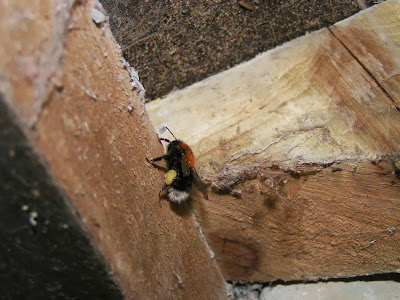15 Things you might not know about bumblebees...
1. It is the female bumblebee that stings
2. Bumblebees can suffer from overheating on very warm sunny days
3. Bees have two pairs of wings whereas flies only have one pair
4. Unlike honey bees, bumblebee nests only last for one season (with exceptions)
5. Usually only the fertilized queens survive the winter
6. Tongue lengths differ a lot between species of bumblebee, depending on their favourite flower
7. If their tongue is too short for a plant, they can bite a hole in the corolla and commit 'nectar robbery'!
8. To make a memory map of the landscape a bee will first fly in ever widening circles away from the nest
9. To tell other bumblebees about a new food source, they will run around the top of the nest buzzing their
wings and bumping into others. A less romantic version of the waggle dance done by honey bees!
10. 3 species of bumblebee have become extinct in Britain
11. Several species were introduced to New Zealand from Britain where they still survive
12. Some species are called cuckoo bumblebees because they will get workers from the nests of other species to raise their young
13. Bumblebees have many lookalikes including flower bees, hover flies, the warble fly and the bee fly
14. There are 239 species of bumblebees in the world (Williams 1998)
15. Central Asia has the richest populations of bumblebees
Source: Bumblebees by Ted Benton, Collins New Naturalist series, ISBN 0-00-717450-0
Bees in our Toilet
Last month a colony of bees decided to make a nest in a cavity under the roof of our outside toilet block here at our office in Windermere. On closer inspection it turned out that these were no ordinary bees but were tree bumblebees (Bombus hypnorum) which were first seen in the UK in 2001 and have become naturalised. What made this sighting even more interesting was the fact it was only the 2nd tree bumblebee nest seen in the Lake District this year!
 |
| A tree bumblebee (Bombus hypnorum) seen outside our office. Photo Roland Wicksteed |
We were able to study these bees really closely, from the comfort of a toilet seat, and watch them as they flew out of the nest and up towards the tree canopy near by. The bees always followed the same route to and from the nest, heading off towards a good food source.
 |
| A large gap under the roof gave the tree bumblebees a warm and dry place to build a nest and form a colony. |
 |
| A tree bumblebee seen returning to the nest, pollen sacks fully laden. |
Tree bumblebees seem to like bird nestboxes for their colonies in other parts of the country, which to the bees is a close match to that of a nice dry cavity in a tree - exactly what a bird box is trying to replicate.
Now that our bee-senses were tuned in to the activites of these beautiful creatures we looked around for more species. The flowers around our office were bowing under the weight of bees, and other insects trying to mimic them to avoid being eaten.
 |
| A bee? No in fact a hover fly |
We also saw bees that on first glance looked like flies because they lacked the bright colours used by bees to warn off anything that might think they were a tasty snack.
 |
| A bee? or a fly? Answers on a postcard please! |
|
What can you do to help bumblebees?
1. Plant native wildflowers in your garden
2. Leave plants such as brambles alone until they've finished flowering
3. Think very carefully before using herbicides, pesticides & fungicides.
Ben Knipe
Woodland Ranger


